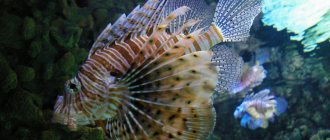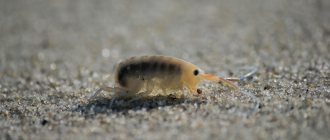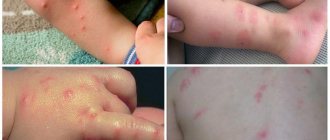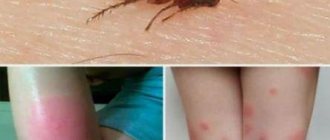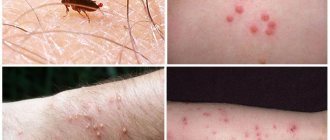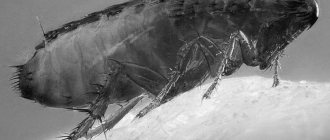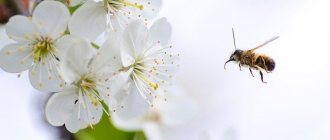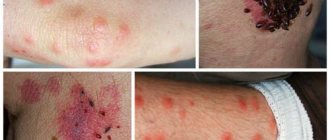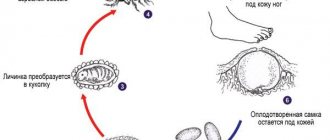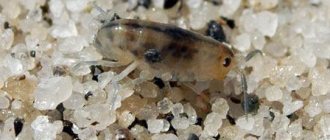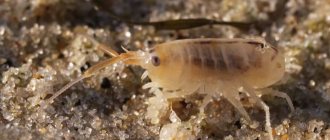The sand flea, Tunga penetrans, is a dangerous blood-sucking parasite. It lives in more than 70 countries with a tropical climate. It is most common in India, the Hainan province of China, Africa, South America, the Caribbean and Southeast Asia. It is mainly found in places not treated for parasites: on the beach in the sand and near bodies of water, as well as in grass, wooden floors and trash cans. Sand fleas cause a serious skin disease called tungiasis, which affects the skin and the area under the nail plate.
Sand fleas - where they come from and why they are dangerous
The insects belong to the genus Tunga. The second name is considered to be “earthen flea”. They are considered distant relatives of rat and cat parasites. The width of the body does not exceed 1 mm, and the length is 1-2 millimeters.
The brown shell is very strong, so it is unlikely that you will be able to crush a flea with your fingernail. Parasites do not have wings, but are capable of reaching from 14 to 36 cm in a jump. Insect larvae resemble small worms. Habitat: grass, hut floors, trash cans.
In addition to humans, domestic animals such as dogs and cats, as well as cattle such as sheep, horses and mules, become victims of pathogens. Attacks on monkeys, mice, elephants, and pigs are possible.
According to statistics, fleas most often attack those who do not wear shoes. Women suffer from bites less often than men.
A surge in insect attacks is recorded in September. But in January you will hardly find parasites.
By the way, these creatures of God bite people selectively. Out of 5-6 people located close to each other, they can attack only one.
The danger is that as a result of the bite of a female sand flea, you can lose your fingers and even die.
This will be discussed in more detail below.
What to do to avoid being bitten by midges in Hainan
You will be 100% protected from midge bites in Hainan only if you walk along the beach in a wetsuit, high rubber boots or some other clothing that completely covers your skin. But you're unlikely to be interested in spending time at the beach in anything other than your bathing suit. So you have to accept that sand flea attacks are still possible. However, if you follow some tips, you can significantly reduce the likelihood of midge bites on the beach in Hainan. First of all, don't go to the beach when it's raining. Sand fleas are very aggressive when the air is cool and humid. For the same reason, we advise you to stay away from the beach in the early morning, evening and night. Secondly, use insect repellent if you feel that midges are attacking. Third, try to cover yourself when sitting or lying down to avoid bites on your body.
Sources
- https://domovod.guru/borba-s-vreditelyami/blohi/peschanyie-blohi-na-haynane.html
- https://hainan-kitaj.ru/sanya/256-moshki-na-plyazhe-na-haynane.html
- https://klopkan.ru/blohi/vsyo-o-blohah/peschanye-blohi-na-hajnane-kogda-aktivny/
- https://turisti.guru/polezno-znat/peschanye-blohi-na-hajnane-sposoby-borby-i-metody-lechenie.html
[collapse]
How to recognize an insect bite
A tourist who is bitten by a sand flea may not suspect anything for at least several more hours. The maximum incubation period reaches 12 days.
The moment of the bite itself is not felt in any way, and the size of the insect, as mentioned above, does not exceed a few millimeters, so it is difficult to notice the flea.
They live on dry and wet sandy beaches. It doesn’t matter whether the place is deserted or crowded - insects will always find a victim.
How to recognize a sand flea bite?
- The skin begins to itch.
- Most often the extremities itch – legs, especially feet, and arms. Damage to the body - neck, back, abdomen, groin - is possible. The genitals, lips, and back of the head may be affected.
- Over time, the itching becomes more intense, and bite marks become obvious. They are larger in size than mosquitoes, and the affected area swells up like a lump. A clear point is clearly visible in the center - the body of the insect.
- If the degree of attack is low, then there are no more than 5 lesions, and with the maximum form - over 30.
- Severe forms of infestation are more common among people of retirement age.
Those who are not particularly knowledgeable can easily confuse a flea bite with the way a bug bites. But the difference is that after the bite of the latter there are no cones left, and they mainly affect the legs.
How a sand fly bites
Unlike a mosquito, which intelligently pierces the skin with a needle in its proboscis, the sand fly simply gnaws out a patch of skin. He gnaws it out so that a neat hole remains.
I used to think that the midge dissolves the skin with acid - the ulcers that remain after the bite are so difficult to heal.
Often the bite is not noticeable and appears the next day as a red bump on the skin with liquid oozing from it.
The flies bite quickly and a lot of them arrive at once. So, if you get into their habitat, the bites can be counted in dozens.
As I already wrote, bites may not be noticeable at first. This is probably why sand flies are also called invisible ( no-see-em ). However, if dozens of sandflies bite, it is impossible not to notice it.
Why are sand flea bites dangerous?
Speaking about the consequences of a bite, it is important to understand whether all sand fleas - both males and females - are equally harmful.
If the victim is bitten by a male, the itching will not be intense. There is no need to fight it; it will go away on its own in a few days.
But if a tourist is attacked by a fertilized female, she will definitely need blood. This is the main danger. The fact is that the sand flea does not just bite, but gnaws into the epidermis.
Most often, she chooses the skin under the nails and between the fingers. Then, due to special enzymes that dissolve the layers of the epithelium, it penetrates even deeper and is absorbed into the blood vessels for further replenishment.
There the flea swells to the size of a small tangible ball, and several hundred eggs mature in it.
The affected area becomes inflamed and ulcers appear. After some time, the insect injects eggs from the wound and then dies.
As a result, the parasitic tropical disease sarcopsillosis may occur. It is also called tungiasis, because, as mentioned above, sand fleas come from the genus Tunga. Complications of the disease are fraught with abscesses and even death.
In addition, insects can cause terrible pathologies:
- sepsis;
- lymphostasis;
- lymphangitis;
- pneumonia;
- loss of nails;
- tissue necrosis;
- thrombophlebitis;
- ulceration to the very bones;
- deformation and even loss of fingers.
The pain from the female's bite is so severe that the victim, whose feet and legs are affected, has difficulty moving.
Laying flea eggs
The female lays eggs under the skin tissue , as a result of which the person begins to feel:
- Edema.
- Pain syndrome.
- Severe itching.
While the pest is in the human body, its size begins to grow several hundred times, as a result, the female increases to the size of a pea. After 6 days, the female seems to “shoot out” already formed eggs. In the process, it loses its new size and dies, remaining under the skin.
Tungiasis can only be cured through surgery. The doctor removes the affected part, carefully examining which you can detect the flea and its offspring. This disease can cause the following complications:
- Thrombophlebitis.
- Necrosis.
- Pneumonia.
- Elephantiasis.
- Finger deformities.
While the female flea is under the skin, inflammation of the tissues around her occurs, and the process of suppuration occurs. Symptoms may not occur unexpectedly, but after about 1-2 weeks, while the flea grows under the skin.
Pain and itching may begin to bother the infected person only after a week. These parasites cause harm not only to humans, but also to animals, such as:
- cows.
- piglets.
- dog, etc.
Livestock and pets develop symptoms in a similar manner to humans. The effect of the presence of fleas in the body is similar to a boil - an abscess that, after bursting or scratching, becomes like an ulcer. If an infection gets into the wound, a necrotic process in the tissues, sepsis or gangrene may occur.
Sand fleas become most active in the evening and at night, when they go hunting. Parasites are most often found in sand near water. A flea bite is somewhat similar to a mosquito puncture. The wounded area turns purple and begins to irritate.
Prevention from sand flea bites
There are a number of ways to avoid encounters with sand fleas:
- Avoid visiting the beach at sunrise and sunset. An early morning boat trip along the edge of the coast is romantic. But it is precisely at this time that the parasites reach their highest activity.
- Apply repellent creams and oils to your skin after each swim. It is important that the repellent is local, it is more effective.
- Wear socks and shoes, and refrain from touching your naked body to the ground.
- Maintain cleanliness in the home.
- Wash your feet in warm water after walking.
- Avoid shady places on the beach.
In addition, before traveling to an exotic country you need to get vaccinated.
Some tourists advise not to lie on the sand at all, but to sunbathe exclusively on a sun lounger. But it is worth considering that fleas can jump high.
Where does the sand fly live?
People on the forum are trying to create an interactive map of the habitats of the sand fly. But unfortunately, it is not possible to predict exactly where the sandflies will be. Sand flies migrate and their numbers depend on the time of year, weather, rainy season, etc.
I can say one thing for sure: if there are algae lying on the beach, then a sand fly is nearby. Sandfly loves damp places and algae washed up on a sandy beach - their home.
Sometimes it happens that in one place of the beach there are sand flies, but 100 meters from this place there are none.
Not everyone gets bitten either. For example, sandflies love me and bite me furiously, but they love my wife less and bite me less often.
What to do if an insect bites you
It is important not to touch the itchy areas. Otherwise, the area of irritation will increase, and liquid will begin to ooze from the bite sites. The most unfortunate way is to give up on the problem without making any attempts to cure it.
You cannot think that the reaction to a bite will go away in a few days. The tricky thing is that the longer the insect is under the skin, the stronger the inflammatory process.
Under no circumstances should you self-medicate or remove the body using improvised means.
The flea is located next to the blood vessels, and if it is accidentally crushed by clumsily pulling it out, complications cannot be avoided.
The female can only be removed surgically. The surgeon removes the insect with tweezers or sterile needles, treats the wound and bandages the operated area. If help is provided on time, the outcome is favorable.
So the best thing to do on vacation is to go to the hospital using your health insurance.
How to get rid of midges if your home is located in an area where they breed in large numbers
If your home is located in areas where they breed or near them, then to prevent yourself from being bitten and to ensure a quiet life without midges, follow the advice of scientists from the University of Florida:
Preparations for the treatment of sand flea bites
Some of the obvious symptoms indicating a bite are tumors and unbearable scabies. Before applying medicinal products, the wound must be disinfected.
Hydrogen peroxide is suitable for these purposes. After this procedure, you can use medications to help get rid of discomfort. They come in three forms:
- cream;
- repellent spray;
- pills.
Each remedy is effective at different stages, depending on the scale of the disaster and the size of the bite.
The most popular antihistamine creams are:
- yellow balm;
- Phenergan cream;
- Fenistil;
- Compound Dexamethasone Acetate Cream.
They perfectly relieve itching and pain, after which the desire to scratch the body disappears, in addition, they are suitable for children. To eliminate scabies and inflammation, you can also use hormonal agents based on hydrocortisone or sulfur ointment.
Preparations containing Aloe Vera will have a calming effect.
Of the repellent sprays, Mentholatum Remos is the most effective.
Its action lasts up to 6 hours. In addition, it is suitable for children aged 4 years and older. You can also use Calamine lotion. This antiseptic speeds up the healing process.
Tablets are divided into antihistamines and antibiotics. Among antihistamines, cetirizine hydrochloride 10 mg (Cetirizine Hydrochloride) is effective. Suprastin and Zyrtec have less effect. These medications reduce scabies, but are contraindicated in children under 7 years of age.
Antibiotics reduce the affected area and itching, but act more slowly than creams.
For example, when taking Hapenxin XX 500mg in capsules, changes become noticeable only after 5-7 days, and complete recovery occurs after 7-8 weeks.
As a rule, both types of tablets are used in combination. The downside is that medications can cause drowsiness.
The best remedies for sand flies
According to scientists from the University of Florida, the main substances active against sand flies are the same as for other midges and mosquitoes: DEET, Picaridin and Permithrin. We provide you with the English names of the active substance so that you can buy such products when you vacation at sea abroad
. We have selected the best for you: two for the body and face, and one spray for clothes.
In the USA, the most popular repellents are those based on DEET (known in Russia as “DEET”). The best-selling brand on American Amazon is Repel 100 Insect Repellent. Costs approximately $7.19.
The second most popular repellent with picaridin is Sawyer Products Premium Insect Repellent with 20% Picaridin. This inexpensive yet effective $8.88 repellent is effective for up to 12 hours against mosquitoes and ticks and promises to provide up to 8 hours of protection against midge bites. Used all over the world since 1998 and most popular in Europe. It is safe for use by the whole family and does not damage clothing, bags, watches and synthetic fabrics. It is completely safe and has a pleasant citrus smell. If you need to use it together with sun cream, then apply the cream first and only after 10 minutes apply the repellent.
A special repellent for clothes with permethrin is available separately.
— Sawyer Permethrin Clothing Insect Repellent. It costs about $14.71 and although it is more expensive than other repellents, it provides protection for up to 6 weeks. The repellent is universal and will cope not only with midges, but also with mosquitoes, ticks and 55 other types of biting insects - which makes it an ideal option for both hiking and long forays into nature.
Permethrin is approved by the US Environmental Protection Agency (EPA), but just in case, keep the spray away from cats - it can negatively affect their nervous system. And the spray has been successfully protecting people from midges for many years: the uniforms of American army soldiers are treated with permethrin.
The repellent is applied directly to clothing and continues to work even after washing (can be washed 6 times). Unlike DEET, which can damage some fabrics and materials, permethrin can even be used on fabrics such as silk, as well as synthetic and waterproof fabrics (does not affect plastics or trims). That is why it can be sprayed not only on clothing, but also on the outside of tents, backpacks, hammocks, outdoor furniture and mosquito nets. Asthmatics should use the product with caution indoors.
Traditional methods of getting rid of the consequences of bites
In addition to medications, there are effective folk remedies that can eliminate itching after a bite. Their essence boils down to the effect of high temperatures on the affected area.
- If you direct a hot stream from a hairdryer to the bite site, you may feel relief. True, you need to blow carefully. Otherwise, you may get burned.
- Instead of a hairdryer, you can use hot cutlery - knives, spoons or forks. The device is placed in boiling water for a couple of seconds, and then applied to the affected area.
- Another alternative is a hot shower. You need to turn up the temperature, which is almost unbearable to endure. Of course, the skin will turn red, but after it is dried and moisturized with cream, the itching will go away.
What are the symptoms that you are infected?
No matter how strange it may be, having crawled under the skin, the female may not betray her presence in any way for 1-2 weeks. Remember, we said that the size of the female is less than 1 mm and while the eggs in her begin to grow, it is impossible to see her. In turn, inflammation begins to appear only after a significant increase in the parasite. The sand flea often affects the following areas of the human body:
- legs;
- feet;
- wrists;
- buttocks and groin;
- back;
- stomach.
This is not a complete list of body parts that are susceptible to damage. In fact, the entire human body is vulnerable. Cases have been recorded in which the flea affected the skin on the pubis, back of the head, eyelids, and lips.
The most common symptoms:
- From the hole in which the female has settled, liquid and products of her vital activity are often released;
- Severe itching, which increases significantly in the dark;
- Unbearable pain, in which a person is unable to fully move;
- The skin around the affected area begins to peel off;
- The wounds begin to emit an unpleasant odor, but only in very advanced cases;
- A person involuntarily scratches the affected areas of the skin due to severe itching. Microbes enter the wound, causing an abscess and suppuration. In the worst case, gangrene and tetanus appear;
- Flea infestations can lead to deformation and amputation of limbs, elephantiasis, pneumonia, necrosis;
- Part of the swollen parasite with eggs may peek out from the wound;
- A dark dot can be seen in the center of the affected area.
Insects with which the sand flea can be confused
It's good to know the enemy by sight. It’s even better to distinguish between its other varieties. In Thailand, other insects can be mistaken for sand fleas. True, their bites are not so dangerous.
- Mosquitoes and midges. Their bites are very similar to flea bites, but are essentially harmless.
- Ants. They can take revenge on a person if he accidentally crushes them with his hand or body. They usually crawl on people by accident. An ant bite leaves a lump that may hurt for some time.
- Bedbugs. They are extremely rare. Mostly in bungalows and not very well maintained hotels. After bedbugs, a “path” of bites remains, but the affected areas never swell.
What does a sand fly look like?
Black dot (1-2 mm) with white wings. Many have encountered this in their homeland: we call it moshka or midge. At the dacha near wet beds, if you bend over, a midge will definitely bite you in the area of your hands or face. In swampy areas, in the tundra, clouds of midges fly.
Two hypotheses about who bites in the sea
1) This is a type of plankton. That is, a variety of small crustacean organisms that live in large colonies and migrate across the ocean at the will of the current.
2) These are microscopic larvae of jellyfish and sea anemones ( cnidarian larva ).
They are called differently in different countries. For example, in Australia they are called sea lice ( sea lice ), in Cuba - Caribbean lice, and in Thailand - Taan Talay (แตนทะเล). The essence is the same: they appear in the sea after rains or storms and sting like nettles.
The behavior of jellyfish is very similar - they also appear in the sea, rich in phytoplankton, of which there is a lot after the sea water is mixed by a storm or sewage is thrown into the sea after rain. By the way, salps, which they write about on the forum, also feed on phytoplankton and appear in coastal waters along with taan talai.
Are there any benefits from salps?
At first glance, it seems that salps are useless sea creatures that bite tourists. In fact, there is scientific evidence proving their important role for the life of our planet. Thus, Gazeta.ru writes that salps, feeding on plankton, passing sea water through themselves, release a carbon dioxide absorber from the upper layers of the ocean and lower layers of the atmosphere. In this original way, nature saves the planet from global warming. Therefore, salps are very useful.
So, now you know that in the Andaman Sea there are no sea bugs, no sea fleas, and certainly no nettles. A marine creature called a salpa can bite you. Tourists are angry with the poor salps for the bites they received and the mood they spoiled. Fishermen also do not like salps because they get clogged in the water intake filters of ships and eat food from valuable species of commercial fish. But, if you remember what a huge role salps play for our planet, saving it from global warming, then the complaints of tourists and fishermen will seem so insignificant!
Animals
How many vacationers are thrilled at the sight of cute monkeys, how many tourists are ready to pet stray dogs, and how many literally faint at the sight of a snake. As a rule, harmless.
Dogs
Gentlemen, there is rabies in Thailand . These are not horror stories, this is harsh reality. Pattaya belongs to the unfavorable red zone. Phuket is much safer. Hua Hin is somewhere in the middle. There are also a huge number of stray dogs living in Thailand. They gather in packs and have long ceased to be the lazy Buddhist dogs of ten years ago. They are often very aggressive. But good Thais believe that dogs are reincarnated people who, in this way, work off their karmic debts from past lives. Offending cannot be fed. Therefore, the number of stray dogs is growing exponentially.
Below is a map of the spread of rabies in Thailand in 2022. Of the 77 provinces, 22 are in the red zone (high risk), 21 are in the green zone (no rabies). The eastern coast of the bay, including Pattaya (Chonburi) and Rayong, are red. Like Prachuap Khiri Khan (Hua Hin). Like the lower part of Isan. From the north it's bad in Nan, Chiang Rai and Tak. But Phuket is green.
I strongly recommend not to wander through the narrow dark streets at night: the likelihood of stumbling upon a pack of dogs is high. Do not pet or approach stray dogs unless absolutely necessary (what???). And have a rabies vaccination .
If anything happens, they will inject you with it here after the fact of the bite. Many insurances cover.
Monkey
Insolent, rude, shameless, dangerous - this is how I see monkeys. Mi-mi-mi what a monkey! This is how tourists see them. In short: stay away from monkeys. They also suffer from rabies, they bite painfully, and finally they can simply take things away. Yes Yes! The actions for a monkey bite are the same as for a dog bite: go to the hospital to get an injection for rabies and treat the wound. They will prescribe antibiotics for good luck, no doubt about it.
The bats
Due to the limited variety of caves in the vicinity of Pattaya, bats are sparse here. There are flying foxes, but they eat fruit and sleep during the day - I don’t know what to do to get them to bite you. But be that as it may, bats are another carrier of rabies. Don't get into the middle of the pack, if that's the case.
